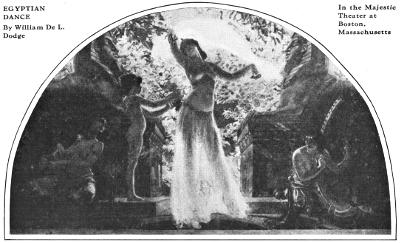William de Leftwich Dodge (1867–1935) was an American artist best known for his murals, which were commissioned for both public and private buildings.
EGYPTIAN DANCE
By William De L. Dodge
In the Majestic Theater at Boston, Massachusetts

Egyptian Dance
Early life and education
Dodge was born at Liberty, Virginia in the Piedmont near Lynchburg. In 1879, his mother, Mary de Leftwich Dodge, an aspiring artist, moved her family to Europe. After living initially in Munich they moved to Paris, where she worked on art. Dodge later followed her example and became an artist. He spent most of his childhood years in France, where his mother was working on art. He studied at the École des Beaux Arts and took first place in the examinations in 1881. He also studied under Jean-Léon Gérôme and with Raphaël Collin at the Académie Colarossi,[1] and traveled to Munich for studies there.
Marriage and family
Dodge received early commissions that gained him attention in the United States, first at the Columbian Exposition of 1893 in Chicago. He was living in Paris when he applied for commissions for mural works for the Library of Congress, which he completed in 1895. This work enabled him to marry Francesca (Fanny) Theodora Bland Pryor, daughter of Sara Agnes Rice Pryor and Roger Atkinson Pryor of Virginia and New York. Her mother was a civic activist and author who published several books in the early 1900s; her father was an attorney and became a justice on the New York State Supreme Court.
He died at his New York City home at 52 West 9th Street in Manhattan. He is buried in Woodlawn Cemetery in The Bronx, New York City
Artistic career
After he and his family settled in New York, Dodge taught at the Art Students League of New York and at Cooper Union.
He became known as a muralist when the genre was at a peak of popularity, commissioned for major public buildings as well as hotels and mansions. Murals were seen as a kind of art that could reach directly to the people. Dodge drew on a variety of styles for his murals, settling on a heroic, neoclassical look. Achieving success with commissions for his murals, in 1906 Dodge designed the classical Villa Francesca, named after his wife, as their family home in Setauket, Long Island.
In his private work, Dodge's paintings show the influence of Impressionism and Fauvism. Toward the end of his career, Dodge became interested in Mayan art. His work is held in the permanent collections of the Metropolitan Museum of Art and the National Academy of Design.
Murals
Dodge's important mural work includes:
murals for the Administration Building dome, designed by Richard Morris Hunt, at the 1893 World's Columbian Exposition in Chicago
murals for the Thomas Jefferson Building, Library of Congress, Washington, D.C., circa 1895
History of Canada murals for the King Edward Hotel, Toronto, Ontario, the subject of a landmark artists' rights lawsuit, 1903
murals for the Onondaga County Court House, Syracuse, New York, 1904
four lobby murals for the Astor Hotel, depicting Ancient and Modern New York, 1904
zodiac ceiling mosaic and other work, at the Surrogate's Courthouse (aka Hall of Records), New York City, circa 1905
mural for the Algonquin Hotel, New York, 1906
works for a number of New York hotels and theaters, including three murals and the color scheme for the Fulton Theatre/Helen Hayes Theatre, architects Herts & Tallant, 1911 (razed)
"Atlantic and Pacific", one of several murals he made for the Panama Pacific International Exposition, San Francisco, 1915
six murals for Buffalo City Hall, Buffalo, New York. Two large murals in the main entrance hall represent the city's role as a border city, while four murals at the end of hallways show the city's work in "Charity," "Protection," "Education," and "Construction." Completed 1931.
ceiling murals of battle scenes, Governor's Reception Room, New York State Capitol, Albany, New York
three murals in the Great Reading Room, Seerley Hall at the University of Northern Iowa. The first is called In Memoriam, the second Education, and the third is a combination of three paintings, called The Glory and Grandeur of Iowa. The three sections of the third are known as Agriculture, The Council of Indians, and The Commonwealth.
Gallery
Sunlit Path, 1891.
Victorian Woman in White, 1891.
Mural in Library of Congress Jefferson building, 1896.
Meditation, 1897.
Last Days at Tenochtitlan (Tulane University - New Orleans, LA) 1899.
Sunken Garden Beneath Wall, Villa Francesca, Setauket, Long Island, 1915.
Buffalo City Hall Mural (Buffalo, New York) 1931.
Buffalo City Hall Mural (Buffalo, New York) 1931.
References
Encyclopedia of Virginia Biography, Under the Editorial ..., Volume 4, edited by Lyon Gardiner Tyler, page 6
This article incorporates text from a publication now in the public domain: Gilman, D. C.; Thurston, H. T.; Colby, F. M., eds. (1905). "article name needed". New International Encyclopedia (1st ed.). New York: Dodd, Mead.
External links
Biography and photograph, Smithsonian American Art Museum site], links to more works
Dodge paintings at the Library of Congress
Works by William de Leftwich Dodge at Project Gutenberg
----
Fine Art Prints | Greeting Cards | Phone Cases | Lifestyle | Face Masks | Men's , Women' Apparel | Home Decor | jigsaw puzzles | Notebooks | Tapestries | ...
----
Artist
A - B - C - D - E - F - G - H - I - J - K - L - M -
N - O - P - Q - R - S - T - U - V - W - X - Y - Z
Retrieved from "http://en.wikipedia.org/"
All text is available under the terms of the GNU Free Documentation License


